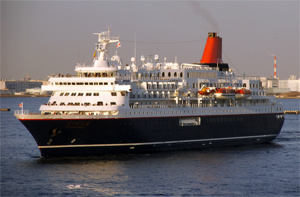Investigators say the master of a Japanese cruise ship was impaired by alcohol when the vessel struck mooring dolphins at a U.S. Navy fueling dock in Guam, causing nearly $1 million in damage.
The incident happened at 2113 on Dec. 30, 2018, as the 547-foot Nippon Maru backed off a dock in Apra Harbor with 624 passengers and crew. The National Transportation Safety Board (NTSB) said the ship was in the process of spinning 180 degrees for outbound transit. As the maneuver unfolded, the master applied astern engine power despite the pilot’s request for ahead propulsion.
Alcohol testing conducted five hours after the incident showed the master had a blood alcohol level of .071, although the NTSB noted it could have been higher at the time of the impact. The incident caused about $456,000 in damage to the ship and more than $500,000 in damage to the mooring dolphins.
“The master’s errors in maneuvering the vessel were not consistent with his level of skill and experience — in particular, his experience with this vessel in this harbor — and suggest that he was impaired during the vessel’s voyage,” the NTSB said in its report, citing alcohol impairment as the probable cause.
Nippon Maru arrived in Apra Harbor early on Dec. 30, and it was scheduled to leave that night for Saipan. The ship, berthed port side to wharves F-4 and F-5, was to back off the dock and spin 180 degrees to port with help from the 106-foot tugboat Talofofo and the cruise ship’s 2,000-hp bow thruster.
The pilot, based in Guam since the early 1990s, boarded the ship at about 2050 and awaited the master’s arrival in the bridge. The two did not conduct the master-pilot exchange required under Nippon Maru’s safety management system, the NTSB said.
The backing maneuver began at 2057 with the master at the conn and the ship’s controls transferred to the port bridge wing. The tugboat and thruster combined to ease the ship off the dock, and with about 60 feet separating the ship from the dock, the pilot ordered the thruster and tug to stop. He ordered the engines to slow astern.
“The pilot stated that the master did not verbally respond to his orders, but based on the movement of the vessel, he assessed that the master was complying,” the NTSB said. “At 2106, the vessel began moving astern, making about 2 knots astern a minute later.”
The ship then began turning to port with the tug assist. The pilot noticed the ship moving roughly 2 knots astern and ordered the ship dead slow ahead with its rudders hard to port to arrest the astern motion. At about this time, the master claimed he lost his sense of orientation and placed the engine control joystick into the astern position.
 |
|
An NTSB timeline constructed from AIS data details the path of the ship. |
|
Pat Rossi illustration |
Soon afterward, lookouts reported Nippon Maru was approaching mooring dolphins at the Navy’s D wharf across the harbor from wharves F-4 and F-5. The pilot sought more power from Talofofo. He also ordered the cruise ship’s engines half ahead. The master appeared to respond, although the pilot could not see the controls to know for sure.
“At 2112:59, the third officer was recorded on the vessel’s voyage data recorder (VDR) telling the master in Japanese that the joystick was now full astern,” the report said, noting the ship was moving astern at 3 knots. “At 2113:17, the third officer again warned the master in Japanese that the joystick was at full astern. Two seconds later, the second officer reported that the Nippon Maru had hit an oil boom that surrounded the D wharf. Four seconds after that, the third officer yelled in English, ‘Ahead! Ahead!’”
At 2113:29, the stern of Nippon Maru struck two of D wharf’s mooring dolphins. At about the same time, the third officer tried to physically move the joystick into the ahead position, but the master immediately placed it back into the astern position.
The second officer reported the contact with the dolphins to the bridge, and the ship returned to its previous berth under its own power. Nippon Maru was holed in its starboard stern and sustained a gash in the port-side stern. Both of the concrete dolphins were damaged, and a catwalk between them was destroyed.
The pilot said that as he prepared to leave the ship, he smelled alcohol on the master’s breath. The master told Japanese authorities he drank one and a half pre-mixed whiskey and soda cocktails between 1700 and 1800 on the day of the incident, despite company policy requiring that crew abstain from alcohol within four hours of their watch. He also claimed to have consumed a beer between 2300 and 2400 after the incident. Investigators suggested the master consumed more alcohol than he admitted.
The NTSB also highlighted other issues preceding the incident, including the crew’s use of Japanese in the minutes leading up to it. The third officer’s admonitions to the master about the propulsion setting, for instance, were in Japanese, which the pilot did not understand. The master also did not verbally comply with the pilot’s orders.
The report stated that the power imbalance between the master and third officer and their apparently rocky relationship also might have contributed to the incident. This scenario, known as the “power distance,” might explain why the master ignored the officer’s suggestion to correct the engine order to ahead, the NTSB said.
“The third officer was the most junior deck officer on the ship, with only a fraction of the master’s seagoing experience,” the report said. “Additionally, he stated that his relationship with the master was poor, and the master refused to be briefed by the third officer prior to getting underway.”
Mitsui OSK Passenger Line of Tokyo operates Nippon Maru, which has since undergone repairs. Attempts to reach the company for comment on the NTSB report were not successful.

